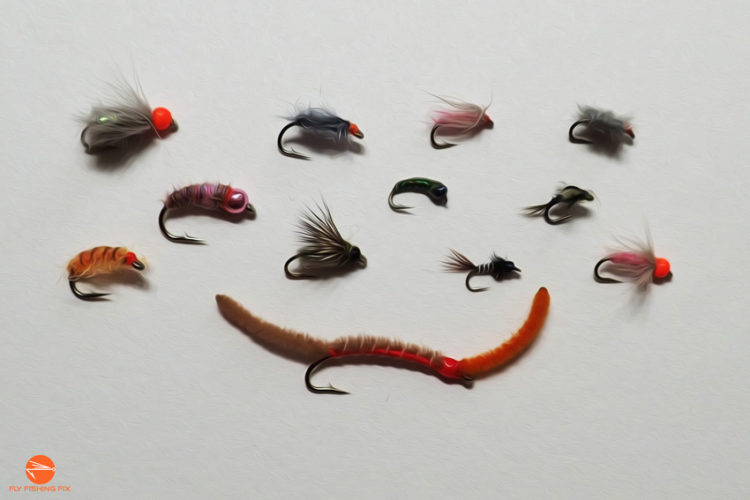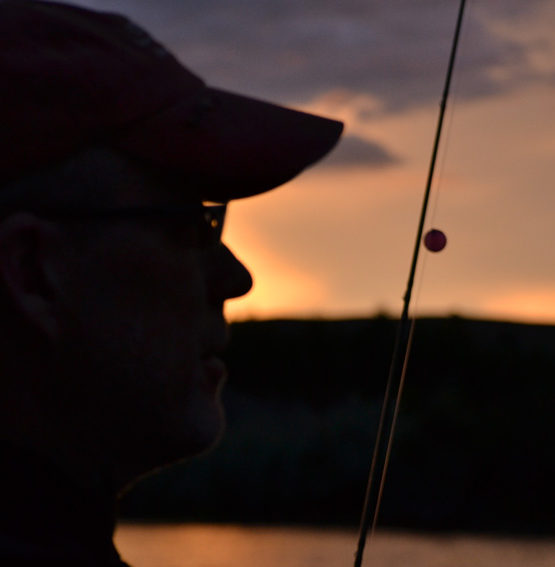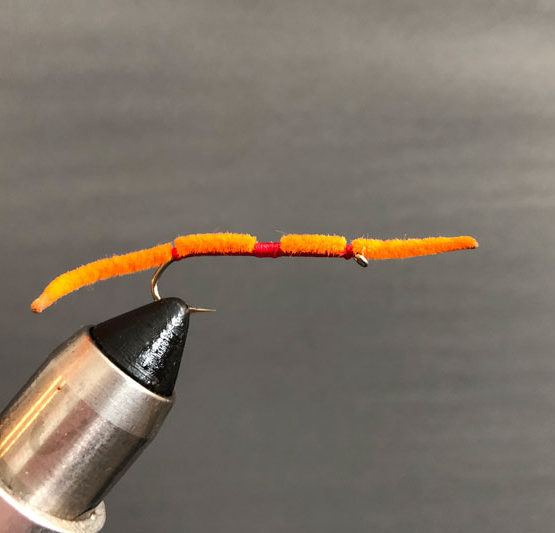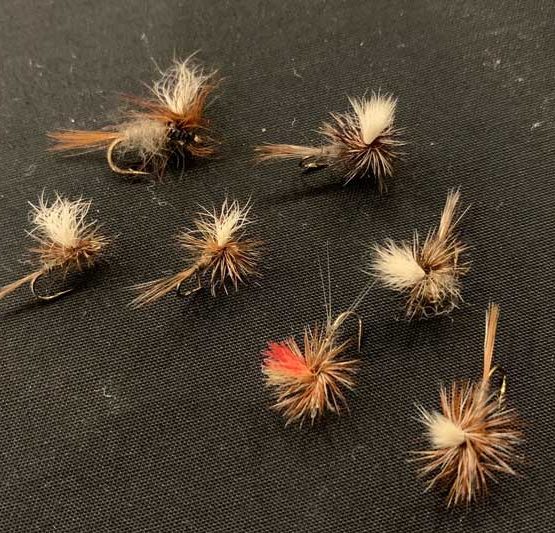If your plans have you headed to The Bighorn River sometime soon, it’s easy to surmise from your arrival to this page that you may be in need of some advice on how to fill your fly box for the trip.
Although time of year has a lot to do with which flies will perform best for you, there are a handful of killer Bighorn River fly patterns that consistently produce and are, therefore, essential components of a well-rounded arsenal.
You can certainly stock up ahead of time by purchasing some of the staples online, or wait and support the local Ft. Smith fly shops in-person when you get there. Regardless, here are our recommendations for the 21 best flies for the Bighorn River.
Disclaimer: This post may contain affiliate links, meaning we will receive a small commission (at no cost to you) if you click through and make a purchase.1. Pink Soft Hackle Sowbug
As a Colorado born and raised fly fisherman, the most colorful fly I had ever thrown was a Royal Coachman, and that, only rarely. The rest of my Colorado fare, aside from the occasional orange bodied Stimulator or a chartreuse Copper John, consisted of what might best be described as earth tone variations. The idea of casting something pink was about as likely as me beating Tiger Woods in a long drive contest.
By the way, Tiger, if you ever find yourself reading this blog post, give me a ring. I’ll forfeit the long drive win to go fly fishing and tip a few cold ones with you.
But I digress.
Cast a pink fly? No way! Yet, as soon as I arrived at the mighty Bighorn for the first time, I gazed at a rather colorful fly case, and saw lots of pink, orange and red. The first three flies on the daily dry erase board were all pink! So, I figured, “When in Rome…” and bought a bunch of Pink Sowbugs (a.k.a Soft Hackle Sowbugs).
Now, in my Bighorn fly box (yes, I have a dedicated Bighorn fly box… or three) the dominant color is pink. It looks a lot like the CandyLand game board in there, and among the most consistently productive groups of flies are what I refer to as “The Killer Pinkies.” Here are a couple of others I also swear by.
2. Firebead Pink Sowbug
Essentially a variation on the standard Pink Sowbug pattern above, this little mighty-might features a neon orangish-red bead head that Bighorn River trout are known to lose their minds over. Given the choice between the fire-beaded or standard version, past success dictates that I opt for the former about eighty percent of the time over the latter. Is it a Scud? Is it a Sowbug? Who cares? Keep several of these in your Bighorn box.
3. Pink Crush
I don’t remember even knowing about the Pink Crush until just a handful of years ago. But that first year, it occupied the number one position on every daily “hot fly” chart I saw. It, therefore, now occupies two full rows in my Montana fly box. Adorned with a pearlescent pink tungsten bead head, pink body, soft hackle, and a more traditional nymph profile, the Pink Crush is the dressed-for-the-ball Cinderella of three Killer Pinkies. And, when it’s on with Bighorn trout, it is very easy to understand how it got its name.
4. Pete’s Carpet Bug
Veering away from the Killer Pinkies but staying in the killer sowbug category, this was one of those flies that came into play much later in our annual Bighorn sojourns. Either we didn’t see it in the bins, it wasn’t on the dry erase boards, or the locals were keeping it under wraps.
Then, suddenly, one year it was everywhere, and, man, did we quickly learn why. The Pete’s Carpet Bug features a dubbed body with a dark back and a red head. Because of the way it’s tied, it takes on a distinctive ribbed appearance as well — kind of like a fuzzy little red-headed tiger, except, in this case, it’s the Bighorn trout doing the pouncing.
5. Ray Charles
Another essential sowbug pattern, word has it the Ray Charles was another one of those flies that was developed specifically for the Bighorn River. The legend says that it got its name because “even someone without their sight could catch fish with it.”
A day on the Bighorn River with a group of buddies means that at least two of us have a Ray Charles on the line at any one time, all day, every day. Why? Because it dominates! Stupid question.
This little dude comes in grey, pink and tan, and is one of those flies that, even beat to a pulp, continues to pull fish. The only drawback to this fly is that suckers and whitefish love it too. If you don’t mind pulling up a giant sucker or hooking up on a whitefish now and then, don’t shy away from casting a Ray.
6. Firebead Ray Charles
Although just a Ray Charles (just a Ray Charles? Is that even a thing?), the Firebeaded version of its amazing cousin deserves its own listing.
Yep, it’s pretty much a Ray Charles with a bright orange bead head. I feel like the pink and grey versions of this pattern do better than the tan one, but that just may be personal preference. Try ‘em all and when a big rainbow comes from the depths to hammer one of them, hang on!
7. Juju Baetis
Switching from the killer sowbug patterns to the “Baetis Bros,” I would have to rank the Juju Baetis among my most trusted Bighorn River flies. Baetis flies hatch frequently throughout the day and year on The Bighorn, and this simple baetis nymph pattern should be a foundational component of every well-rounded fly box.
Yes, the Juju Baetis works well on just about any river that sees baetis hatches. Which is another way of saying, it works on every river.
8. Skinny Nelson
Widely acknowledged as having been developed by Tracy Peterson explicitly for the Bighorn River during a period of unusually low flows, the award-winning Skinny Nelson (not sure why it’s not called the Skinny Peterson) caught fire and quickly became a staple Bighorn river fly that, like many of its brothers and sisters, works well elsewhere.
Skinny Nelsons come in both weighted tungsten bead headed and unweighted versions, and feature a black, gold wire-ribbed abdomen, a pheasant tail fiber tail and a tuft of peacock herl striped with a pearly flashabou wing case.
It’s unclear whether this fly should be classified as a baetis or midge but, again, who the heck cares? This bad boy works!
9. Bighorn Baetis
Yet another baetis variation, the Bighorn Baetis caught my eye one day while I was picking out some Jujus and Skinny’s. It just looked tasty, so I bought a few and, bam! They hit, and I proceed to net about twenty nice trout on the Bighorn Baetis pattern that very day.
I retired the most mangled version to my hat of fame over a cold one. Now, of course, it’s a staple in my quiver of go-to Montana flies. This nymph seems to be a rather complimentary trailing nymph behind a larger, colorful scud pattern.
10. Wonder Nymph
I wonder how I ever got along as a fly fisherman without the Wonder Nymph!
Another dynamite baetis pattern, this fly works when nothing else seems to. It also seems to work well regardless of whether or not there’s an active baetis hatch underway.
This pattern was developed by Bighorn veteran guide, Brad Downey. If I ever met him, I might just have to genuflect to his brilliance. With a black body, a black and white partridge tail, its defining characteristic is a grizzly aftershaft hackle that, when correctly tied in, comes off as a slightly messy and wispy feathered wing structure that drives Bighorn trout out of their minds. I’ve even been known to run a triple nymph rig populated entirely with Wonder Nymphs. Unorthodox? Maybe. Killer? Yep!
11. Blue-Winged Olive
If you don’t have a supply of Blue-winged Olive imitations, you better get with the program.
I’m no entomologist, but the Blue-winged Olive has to be one of the most commonly occurring mayfly hatches on the planet and, if not, certainly on the North American continent. What we love about this type of baetis mayfly is that it hatches throughout the year and tends to favor a bad weather emergence. This is good news for the springtime Bighorn River angler, but it’s a go-to dry most anytime.
12. CDC Sparkle Dun
A fantastic Bighorn BWO (or general “any ‘ol” mayfly) imitation is the CDC Sparkle Dun. This fly is favored by all the local Bighorn angling vets. In other words, you won’t have any trouble finding a few laying around in the Ft. Smith fly shops.
This simple but elegant adult mayfly imitation features what fly tiers will know as a Darlon or Z-Lon shuck, which is a rust-colored tail section that fish apparently interpret as a trailing nymphal husk that is still hanging on to an emerging adult. Think whipped cream on a slice of apple pie. Can any trout really resist that? Not likely.
13. Scud
I love scuds! Yes I do. I love scuds. You should too! For the uninitiated, the scud pattern mimics — rather accurately I might add — an aquatic crustacean. A friend of mine once found a waterlogged rollie pollie in his water glass at a restaurant. It looked just like a scud and, the better news, it wound up earning us a free lunch!
On the Bighorn, Scuds in orange, olive and tan are standard fare. They serve well as the point bug on a multi-fly nymph rig. Sometimes the beefier size 12s work well while at other times, we’re running with 16s or smaller. Orange and olive work best for me, but I keep a couple of tan ones in my box too.
Mix and match for Scud success!
14. Greenie Weenie
A.K.A. Green Weenie, but not as fun to say, the Bighorn River version of this common and otherwise fuzzy green inchworm imitation features a sleek, simple green and turquoise striped body, a dark purple or black tungsten or glass bead head and, well, a sharp hook at one end. Except for the bead, it might as well be a green wrapped hook!
My favorite Bighorn River guide turned me on to this dyno-mini midge pattern and, with varying degrees of success ranging from great to fantastic, I’ve used it ever since. I’ve also found that it can draw trout fire as a caddis pupa imitation.
Because trout seem to love it on the swing, with a subtle lifting retrieve motion and, maybe a little rod tip wiggle, I almost always use the Greenie Weenie as my trailing nymph in a multi-fly rig.
Never be afraid to swing and wiggle your Greenie Weenie, I always say.
15. Root Beer Midge
Though another absolute staple in any self-respecting Bighorn River fly box, the Root Beer Midge works well in many a tailwater.
This nymph’s body is, as you might expect, root beer colored (and ribbed) while the thorax/wing section is usually made up of white hackle.
I’ve seen this midge with a simple black thread head, a copper bead or a root beer colored glass bead. When this fly is on, it tends to be way on, so make sure your Bighorn fly box is stocked with plenty of beer… root beer, that is. Save the real stuff to wash down breakfast.
16. Zebra Midge
Every angler has a set of favorite flies — patterns that call to them when they open their boxes — that draw their trust like steel to a magnet. Conversely, if they’re being honest, most anglers have a few flies that just don’t seem to work as well for them as they do for others. The Zebra Midge is mine.
For some reason, this renowned pattern, whether red or black, hasn’t found its way into my heart as one of my go-tos. My bias aside, the Zebra Midge has probably been one of the most versatile and productive midge patterns since the dawn of time. In fact, I’m pretty sure Adam used Zebra Midges in Eden, and to undoubtedly great success, I would surmise.
Bighorn trout seem to love colorful little flies and, when I’ve had success with the Zebra Midge, it’s usually been with the red version. No fly box, Bighorn or otherwise, is complete without several Zebra Midges in both red and black.
17. San Juan Worm
Let’s talk worms! San Juan Worms to be exact. This may sound like a broken record but, over the course of a day on the Bighorn River, it’s a fairly rare occurrence for me not to have some form of San Juan Worm on my line.
Several years ago, three of us were fishing the Bighorn together. The river had been suffering from several years of drought-induced low flows, but this particular year was different. It was June and the river, for the first time in a long time, was cramming its banks with flows near 10,000 CFS. Usually crowded with at least ten hot flies, the local white boards listed one: San Juan Worms.
We all started out with standard double nymph rigs, dutifully equipped with a worm as the lead bug. In short order, and as a result of worm-gorging trout, our rigs became annelid smorgasbords, often three deep. That was the case for the rest of our trip.
Color didn’t matter.
Length didn’t matter.
Type didn’t matter.
It was an all-out worm feeding frenzy marked by trout defiling our nets with vomited globs of semi-digested worms they simply didn’t have room in their gullets to accommodate.
Hang on. I’m gonna need a minute…
Okay, I’m back but still a little dizzy.
Anyway, to put a fine point on it, stock your fly box with a variety of San Juan Worms. I like the brown and orange combo, but red, orange, pink, burgundy, tan, all-brown, micro-worms, heck, they all work! Confession: I have a whole box dedicated to San Juan Worms, but I bet you knew that.
18. Orange Red Wire Worm
In a class by itself, the Orange Red Wire Worm should certainly occupy a few slots in your Bighorn River fly box. This big, gnarly worm pattern is heavy, stiff, durable and, well, dang productive. Because of its hook and wire construction, it easily sinks down to where the fish are and, once there, is treated as an irresistible edible.
This pattern, though terribly effective, can also leave a terrible mark on caught trout, so, if you’re not doing so already, be sure to crimp down the barb on this bad boy.
19. Black Caddis
If you’ve read other Fly Fishing Fix blog entries, it’s no secret that we FFF Colorado boys have a rather strong affection for Montana’s glorious Bighorn River. (Ya think?) We should, we’ve made it an annual tradition for about the last fifteen to twenty years. Trouble is, the only time our group seems to be able to go together is mid-June, right around Father’s Day.
June on the Bighorn is mostly a month of big water nymphing. That said, there have been a couple of years when it got warmer a little earlier; when the CFS came down and the Black Caddisflies came up.
Normally a later summer occurrence, the Bighorn River Black Caddis hatch is impressive and creates a great opportunity for us to scratch our dry fly itch. If you hit the river in late July through September, you’ll see a lot more Black Caddis hatches than we do in June, but stocking your box with a selection of good Black Caddis imitations is a must.
The local shops will point you to the best patterns but don’t be surprised if their recommendation starts with Dill’s CDC Black Caddis. Yeah, it’s a winner. Oh, and, if you’re going to fish Black Caddis dries, it makes a whole ton of sense to stock a few Black Caddis Emergers too, don’t you think?
20. Trico (Duns and Spinners)
Tricos hatches are one of those enigmatic natural occurrences that can either result in angler ecstasy or angler anguish. Sparing the Trico biology lesson for a future post, the fact of the matter is that Trico hatches, though, frequent and mind-bogglingly profuse, can be difficult to fish.
Every dedicated fly fisher has likely endured a Trico hatch during which feeding fish are eating Tricos, like sorority girls eat popcorn, everywhere except at the end of their line.
On the other hand, if you’re lucky enough to catch a Trico hatch just right — typically in the morning hours on slower moving water between August and October — the fish-fest you’ll enjoy will probably be short but epic.
Keep a selection of black (male) and pale green (female) dun and spinner patterns from size 18 to size 24, if you dare. Sometimes, a good ‘ol Adams or Griffith’s Gnat pattern will draw strikes amid a Trico carpeting as well.
Regardless, Tricos hookups require excellent and precise dry fly fishing techniques, so while you stock your box with Tricos, brush up on your research and hone your skills.
21. Hoppers
If you’re headed to the Bighorn River any time from about July 1 through September-ish, it’s a good idea to have a well-stocked terrestrial box, the largest portion of which should probably be dedicated to hoppers.
In the Ft. Smith area, summer afternoons bring lively grasshopper activity together with fairly hearty winds. This is a made-in-heaven recipe for wayward hoppers becoming floating and twitching t-bone steaks for predatory trout. Sorry Mr. Grasshopper, it sounds harsh, but, you know, circle of life kind of thing, and you’re pretty much at the bottom rung of the food chain. Stories of ferocious hopper strikes from large Bighorn rainbows and browns are as numerous as they are legendary.
Our recommendation is to pad your Bighorn terrestrial array when you get there. Locals will likely steer you to the Pink Morrish Hopper (oy with the pink patterns!) and the Parachute Hopper in sizes 8 to 14, but a wide variety of hopper patterns will work.
Trust the local experts, and don’t be afraid to splash a hopper away from the bank. Typical bank-combing with hoppers will certainly work, but the stiff winds often carry them well out into the river where opportune trout won’t hesitate to attack. It’s also a good idea, whenever you’re fishing hoppers, to give them a little mend & twitch treatment. I mean, no one really likes eating a dead grasshopper. Not even Bear Grylls.
Related Content:
- 7 Best Strike Indicators For Fly Fishing
- How To Tie A Dry Dropper Rig (5 Simple Steps)
- Fishing The Bighorn River In Montana: The Ultimate Guide
- 10 Baetis Nymph Patterns You Need To Try
- 25 Best Dry Flies For Colorado Fly Fishing
- 25 Proven Tips To Catch More Trout
Final Thoughts
So there you have it, Fly Fishing Fix’s Bighorn River Fly Honor Roll.
I must say, one of the best parts of having a fly fishing blog is getting to hear from our readers. This list of 21 essential Bighorn River flies is our selection. We are quite certain there are other winners we haven’t included. That’s where you come in.
Please join Fly Fishing Fix and offer your best Bighorn River flies in the comment section below. At the very least, your esteemed FFF purveyors will learn about some more great flies to use the next time we head north to one of our favorite Montana rivers!
Tight lines!










